2020–2021 Agricultural Research Institute of Ontario annual report
About the Agricultural Research Institute of Ontario (ARIO)
The Agricultural Research Institute of Ontario (ARIO) is a non-profit corporate agency of the province continued under the Agricultural Research Institute Act (ARIO Act). It reports directly to the Minister of Agriculture, Food and Rural Affairs. Under the ARIO Act, the ARIO’s responsibilities include:
- providing strategic advice to the Minister on agri-food research
- owning and providing managerial oversight of 15 research properties across the province
- leading the modernization of the province’s agri-food research infrastructure
- stimulating interest in research to develop in Ontario high efficiency in the production and marketing of agricultural products
- entering into arrangements, at the request of the Director of Research, for the preservation and protection of agricultural lands in the province
The Ontario Government, through the Ontario Ministry of Agriculture, Food and Rural Affairs (OMAFRA), is ARIO’s primary funding source, although programs are supported through other sources as well, as permitted under the ARIO Act. Additional funding sources come from commercial sources and royalty revenues and can be designated or non-designated for specific projects.
What does ARIO do?
Provide strategic advice, advocacy and leadership:
ARIO provides advice to the Minister on strategic directions for research activities that contribute to prosperous, competitive and sustainable agricultural and food sectors and rural communities in Ontario. ARIO is also an advocate for the importance of a robust research system.
Research property management:
Research stations and infrastructure are an important platform for conducting agri-food research. ARIO owns 15 research properties located across Ontario. These facilities provide the capacity for research on a wide variety of agri-food issues. An ARIO-led reinvestment strategy is currently being implemented to revitalize research infrastructure to support demand-driven research.
ARIO Members
ARIO is comprised of up to 15 members who reflect the broad-based nature of Ontario's agri-tech industry such as:
- farmers
- agribusiness and rural partners
- researchers
The Institute members are committed to:
- excellence and innovation in agri-food and rural research
- relevance of research to needs of industry and society
- efficient, well informed decision making
- ethical research practices
Federal perspective
A director from Agriculture and Agri-Food Canada serves as ex-officio to ARIO. She or he contributes to ARIO a federal perspective about research activities across Canada.
Memorandum of Understanding
A Memorandum of Understanding (MOU) defines the relationship between the Minister of Agriculture, Food and Rural Affairs and ARIO. Its purpose is to:
- establish the accountability relationships between the Minister of Agriculture, Food and Rural Affairs, the Director of research and the chair of the Agricultural Research Institute of Ontario on behalf of the Agency
- clarify the roles and responsibilities of the Minister, Director of Research, Chair, Deputy Minister, Comptroller and Agency's members
- clarify the operational, administrative, financial, staffing, auditing and reporting arrangements between ARIO and OMAFRA
ARIO Mandate Letter
In the ARIO 2020–21 Mandate Letter, the Minister of Agriculture, Food and Rural Affairs outlines expectations and direction for ARIO in the year ahead. The work completed by members to establish the goals, objectives, and strategic direction ensures that ARIO continues to support research and innovation in the agri-food sector and drive economic growth, jobs and sustainability in Ontario. As part of the government of Ontario, agencies are expected to act in the best interests of Ontarians, which includes adhering to the following priorities:
1. Property management
- Operating within the agency’s allocations.
- Identifying and pursuing opportunities for revenue generation, innovative practices and/or improved program sustainability.
- Identifying and pursuing efficiencies and savings.
- Complying with applicable direction related to supply chain centralization.
2. Strategic advice
- Continue to provide strategic advice to the Minister and the Ministry of current research issues and priorities and contribute to prosperous, competitive and sustainable agricultural and food sectors and rural communities in Ontario.
- Provide strategic advice to the Minister and the Ministry on long-term research needs of the agri-food sector that will enable the agriculture and food sectors to remain a global leader in years to come.
3. Promotion and advocacy of Ontario’s agri-food and agri-products research and innovation system
- Advocate for the value of Ontario’s agri-food and agri-products research and innovation system through focused outreach opportunities, building relationships between ARIO and industry stakeholders to broaden awareness, engage and seek support for research and innovation priorities and the research infrastructure renewal needed to maintain and strengthen Ontario’s local, national and global competitiveness.
- Develop a plan to better communicate the value and return on investment for ARIO infrastructure and the research system it supports.
4. Efficient and effective administration
- Continue sourcing secretariat services from OMAFRA that provide effective and efficient administration of Ministry open research programs, timely and accurate financial operations and reporting, and all aspects of property management and capital revitalization.
- Continue to meet all Agencies and Appointments Directive (AAD) provisions and other government directives as requirements.
2021–22 ARIO members
| 2021–22 ARIO members | Appointment date | Expiry date | Per diem renumeration |
|---|---|---|---|
| Dr. Lorne Hepworth (Chair) | January 18, 2019 | January 18, 2022 | $221 |
| Ms. Rose Marie Gage (Vice-Chair) | March 9, 2018 | March 8, 2024 | $184 |
| Ms. Jennifer Doelman | March 8, 2021 | March 7, 2024 | $168 |
| Mr. David Jenkins | November 30, 2020 | November 29, 2023 | $168 |
| Mr. Nevin McDougall | November 30, 2020 | November 29, 2023 | $168 |
| Mr. David McInnes | November 30, 2020 | November 29, 2023 | $168 |
| Dr. Gord Surgeoner | June 2, 2005 | March 12, 2022 | $168 |
| Mr. Evert Veldhuizen | January 2, 2019 | January 1, 2022 | $168 |
| Mr. Ken Wall | December 7, 2020 | December 6, 2023 | $168 |
| Dr. Youbin Zheng | January 21, 2021 | January 20, 2024 | $168 |
| Director of Research | Lee-Ann Walker |
|---|---|
| Comptroller | Sue Mihelchic |
| Agriculture and Agri-Food Canada ex-officio representative | Marie-José Loffredo-Forest, Director General, Agriculture and Agri-Food Canada |
| Secretariat Support to ARIO: OMAFRA’s Research and Innovation Branch Staff | Jen Liptrot, Director – Research and Innovation Branch Kelli Rice, Manager – Research Accountability, Management, and Administration Unit Adam Meyer, Manager – Research and Knowledge Management Unit |
ARIO is comprised of up to 15 members, appointed by the Minister of Agriculture, Food and Rural Affairs. Members can be recommended by the Chair to ensure a strong mix of skills, experience and perspectives. Board members are appointed for three-year terms and may be reappointed. In 2020–21, six new members were appointed and there are currently ten members.
In 2020–21, three meetings were held. Discussions included a variety of topics such as research priorities and the impact of COVID‑19, infrastructure strategy and build updates, ARIO communications materials, discussions with OMAFRA’s Deputy Minister, COVID‑19 recovery strategies and strategic planning.
Letter from the Chair
September 2021
The Honourable Lisa Thompson
Minister of Agriculture, Food and Rural Affairs
Legislative Buildings, Toronto, Ontario M7A 1A3
Dear Minister Thompson,
I am pleased to share the 57th Annual Report of the Agricultural Research Institute of Ontario (ARIO) for the 2020–21 fiscal year. ARIO continues to deliver on its key mandate despite the challenges that have arisen from the COVID‑19 pandemic.
The COVID‑19 pandemic has identified the pressures and challenges of ensuring a safe, abundant and stable food supply during a time of a significant shock to the broader Ontario economy. The pandemic has caused dramatic changes to the agri-food system including labour challenges, supply disruptions and changes in commodity prices. Continued investment in modern research platforms by the ARIO serves to assist Ontario’s agri-food sector in adjusting to shocks brought about by the global pandemic. Advancements in livestock, field crops and greenhouse research at ARIO research stations drive innovation while also providing “made in Ontario” solutions to issues arising from the pandemic. The COVID‑19 pandemic has laid bare the importance of domestic food security and the need for Ontario-based research that builds on Ontario’s core strengths in food production and processing.
During this challenging past year, ARIO has continued to advance key components of its research infrastructure renewal strategy, build partnerships across the agri-food value chain and emphasize the importance of research and innovation as the way to build and maintain Ontario’s competitive advantage in the agri-food and the agri-products sector moving forward.
Looking ahead to the 2021–22 fiscal year, ARIO will continue to endeavour to make strides despite fiscal challenges stemming from the COVID‑19 pandemic. Modernization of core research capacity and platforms in several key sectors ranging from livestock and field crops to aquaculture remains at the core of the ARIO’s plans. Continued modernization of research platforms and infrastructure will ensure Ontario producers are positioned for success as the province emerges from the pandemic.
These projects include, but are not limited to:
- construction for the new beef feedlot at the Ontario Beef Research Centre in Elora, which features advanced precision feeding capacity for beef nutrition research
- commencement of construction of the new Ontario Swine Research Centre at the Elora Research Centre
- engagement with feather boards to discuss future poultry research investments in Elora
- plans to construct a new feed mill at Elora to support swine nutritional research and potentially poultry in the future
- completion of expanded feeding and preparation capacity to support the beef and dairy research herds at the Elora Research Station
- two new Agronomy Research Services Buildings at Ridgetown and New Liskeard which allow for upgraded field crops research capacity in both northern and southern soil conditions
- continued disposal of surplus assets at Alfred, Kemptville, New Liskeard, Arkell and Guelph subject to any legal requirements
Together, with industry partners and the research community, ARIO will continue to focus on targeted investments in the agri-food research sector that benefit Ontario’s economy and ensure continued growth and sustainability as we emerge from the pandemic in the years ahead.
With a broad range of knowledge and skills, ARIO members will continue to provide strategic advice, demonstrating adaptability and flexibility through COVID‑19 recovery.
Ontario’s agri-food sector has demonstrated tremendous resiliency in its capacity to deliver food to Ontarians in spite of the pandemic. It is through previous and continued investments in agri-food research capacity that enable the Ontario agri-food sector to provide innovative solutions and technologies that safeguard the province’s food production capacity.
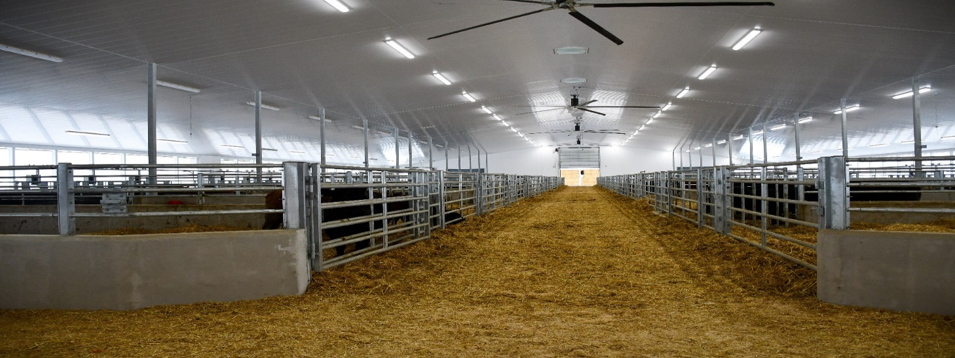
The agri-food sector will continue to be a cornerstone of Ontario’s economic strength and success and we continue to be excited about the investments in infrastructure and research projects we are making that will support agriculture in this province long into the future.
Sincerely,
Dr. Lorne Hepworth
Chair, Agricultural Research Institute of Ontario
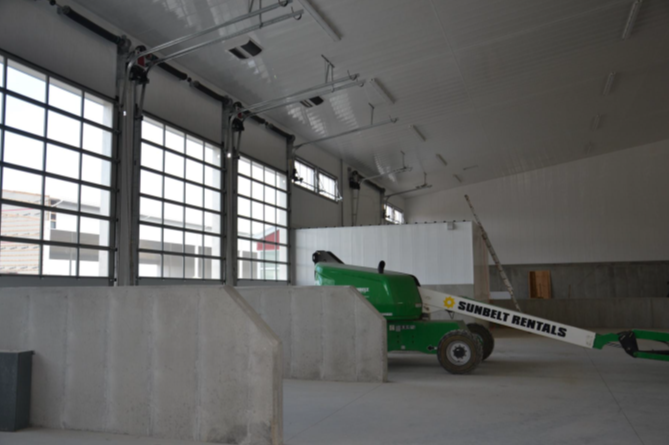
Chair and Director of Research’s report
We are pleased to provide an update and some highlights from the 2020–21 fiscal year for the Agricultural Research Institute of Ontario (ARIO) and its continuing support of agri-food research and innovation in Ontario.
Research infrastructure strategy
ARIO’s research infrastructure strategy provides a plan for the renewal and modernization of Ontario’s network of agri-food research stations. Implementation of the ARIO Infrastructure Strategy is resulting in a state-of-the-art multi-disciplinary research and innovation platform focused on consumer, market, and economic outcomes. Benefits include the creation of new and value-added products, developing solutions to current and emerging issues and validating new technologies, processes and approaches to Ontario conditions.
A cornerstone of ARIO’s infrastructure strategy is industry engaging directly with government and academia to address the highest research priorities and needs of the Ontario agri-food sector. Modernized infrastructure enables scientific excellence, knowledge dissemination and industry adoption, all of which are necessary to the economic growth of the agri-food and agri-products sector for the province.
ARIO continues to plan and make strategic infrastructure investments through the ARIO infrastructure strategy. The strategy is supported by industry who provides capital dollars to projects (typically 20%) and is guided by two key pillars which seek to modernize research infrastructure, as well as drive operational efficiencies across the research station portfolio through consolidations of facilities and livestock.
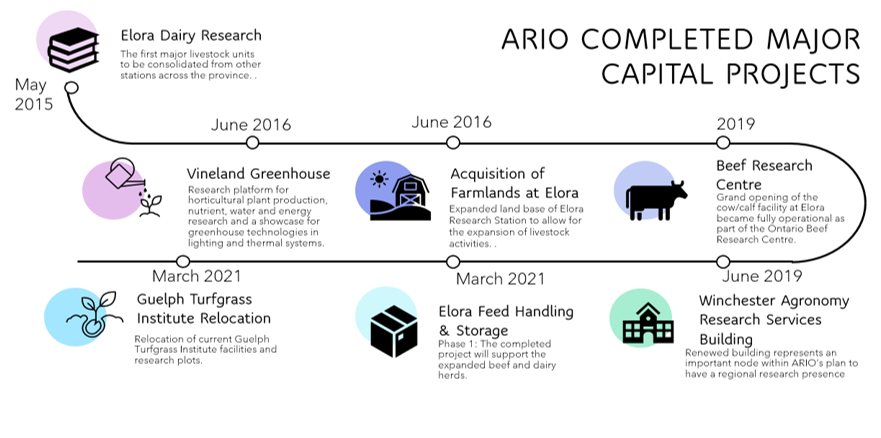
Evidence of this reinvestment in research infrastructure in a time of significant challenges related to the COVID‑19 pandemic can be seen in various ARIO projects across the province:
- Commencement and continued construction of two new Agronomy Research Services buildings at Ridgetown and New Liskeard which support field crops research needs in southwestern and northern Ontario while allowing ARIO to dispose of a wide range of older field crops buildings within the ARIO portfolio which are expensive to maintain and past their useful lifecycle for research.
- Substantial completion of the new Guelph Turfgrass Institute located at the University of Guelph Arboretum, as part of the broader divestment (in-progress) of the former Guelph Research Station.
- Commencement of construction for a new beef feedlot in support of research. This addition to the Ontario Beef Research Centre complex allows for the consolidation of the province’s entire beef research herd to Elora from other areas of the province. ARIO can now dispose of several older beef buildings no longer suitable for research, which are costly to operate and maintain due to their age.
- Completion of the advanced design phase of the new Ontario Swine Research Centre. The new centre at Elora will replace the present facilities at Arkell which are well past their useful lifecycle, costly to operate and difficult to retrofit due to age. The planned research facilities will more closely resemble the current state of industry production taking place in Ontario, leading to better applied research outcomes for the sector.
The ongoing work and completion of these major projects is evidence of how the ARIO Infrastructure Strategy is continuing to proceed, despite challenges.
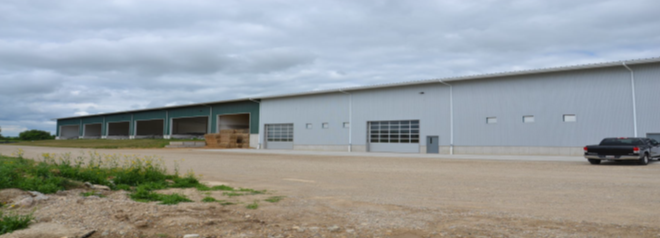
Property management
The University of Guelph and the Vineland Research and Innovation Centre (VRIC), in addition to providing program delivery, have operated the ARIO-owned research stations and provided property management services, including the minor capital program, under agreements with ARIO.
Minor Capital Program
The ARIO Minor Capital Program (MCP) is an ongoing multi-year program that allocates funds across the ARIO property portfolio to support significant investments in addressing maintenance, upgrades, program related systems, equipment and building/site infrastructure. The MCP is in line with ARIO’s broader Infrastructure Strategy to target development and renewal of ARIO’s core research infrastructure and to support the move away from aging infrastructure by creating operational efficiencies through consolidation and co-locations to reduce the overall footprint of the research stations.
Criteria for determining MCP needs on an annual basis is guided by priority areas such as safety (human and animal), regulatory, building integrity and equipment failure issues that affect building and program operations across the network of ARIO properties.
Annual minor capital plans are submitted to ARIO by the University of Guelph and VRIC at the beginning of each fiscal year outlining the priority projects for each research station. These projects can be completed throughout the fiscal year or can cover multiple fiscal years depending on the size and scope of the project.
The program is funded through an annual transfer payment from OMAFRA and is supplemented by revenues generated by the ARIO, such as tenant revenues.
Research programs
The ministry’s open research programs, New Directions and Food Safety, previously administered by ARIO, were replaced in 2019–20 by the Ontario Agri-Food Research Initiative (OAFRI), funded through the Canadian Agricultural Partnership. This initiative combines and builds on the success of the former OMAFRA New Directions and Food Safety research programs. Priorities for the 2020–21 application year were food safety, plant health and protection and sustainable production systems.
While no calls for proposals were launched for either the New Directions or the Food Safety research programs in 2020–21, multi-year active projects continue to be administered by the ARIO until they are completed.
ARIO also continues to administer active projects under the 2018–19 Quebec Ontario Cooperation for Agri-Food Research program until all projects are completed in 2022.
Access to ARIO research infrastructure
Researchers continue to leverage the ARIO network of research stations through the Ontario Agri-Food Innovation Alliance. University of Guelph researchers are provided subsidized access to the ARIO research stations to enable a broad spectrum of research across the agri-food sector. This is a highly valued resource for researchers and helps maximize the utilization of ARIO’s research infrastructure. Examples of projects in 2020–21 include:
Competitive production systems:
- Genetics and breeding for resistance to sudden death syndrome in soybeans
- An innovative approach to thinning peaches for improved labour efficiencies, fruit quality and orchard economics
- Molecular marker assisted selection for improved seed protein content in dry bean
- Survival of ice encasement in winter wheat
Plant health and protection:
- Evaluate non-insecticidal control tactics that can be used in an Integrated Pest Management program in order to improve Colorado potato beetle management in field tomatoes and potatoes
- Develop Integrated Weed Management (IWM) programs to combat weeds including multiple-herbicide resistant weeds through crop rotation, reduced row widths, cover crops, new herbicide-resistant crop hybrids/cultivars and multiple effective herbicide modes-of-action in corn, soybean, dry beans and cereals
- Identification and management of Pythium diseases of carrots. New molecular methods will be developed and tested to determine which species of the pathogen are present and to assess field soils for the presence of the pathogens, so growers will be able to avoid high risk fields
- Modernizing management of True Armyworm (TAW) in Ontario. Project will improve detection and surveillance of TAW that will be accessible for Ontario cereal producers in real-time
- Innovative weed management strategies for the control of common weeds in dry beans in Ontario
Animal health and welfare:
- Enhancing piglets and chick’s ability to produce an immune response to pathogens. SARS-CoV-2 in mink: development of a vaccine and serological testing
- Assessing above ground burial as a swine mortality management strategy in Ontario
- Non-antibiotic alternative to improve calf health. Investigating stillbirth and neonatal mortality in pigs
- Development of vaccines against NE (necrotic enteritis) in chickens
Research priority setting
OMAFRA continues to deliver on the Government’s agenda contributing to jobs and investment, environment and climate change and safe food and public assurance. To support delivery, the research agenda provides the overarching framework for the ministry’s research investment, aligned with OMAFRA’s core businesses. It was developed in 2019 following senior management direction to clearly link research focus areas to outcomes we are trying to achieve under each core-business, based on integrated advice from across the ministry.
As a foundational framework, the eleven Research Agenda Priority Areas are meant to remain static, however, research focus areas and research questions thereunder are reviewed annually and updated accordingly as part of the annual research priority setting cycle.
ARIO provides advice to the Minister on strategic direction for research priority setting. This includes providing advice to the Minister on emerging research issues and opportunities to drive the development of Ontario as a global leading agri-food sector.
OMAFRA’s research agenda informs a range of ministry programming that spans across the research and innovation continuum. Program levers allow engagement of different partners with a diverse range of expertise and is flexible to support varied degrees of intervention, directedness and specificity of priorities. This is a long-term strategy that fosters and creates space for innovation and research to occur.
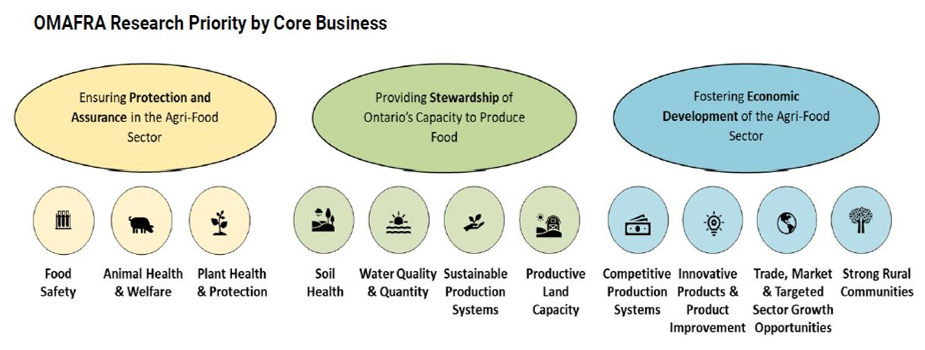
Knowledge Translation and Transfer
Knowledge Translation and Transfer (KTT) programming takes the results of provincial research and innovation investments that have generated new knowledge and drives the use of that new knowledge to yield real impacts in the sector and positively influence business decisions. Every Ontario Agri-Food Innovation Alliance and OAFRI research program proposal is required to have a knowledge transfer and translation plan which identifies key target audiences for research outcomes and outlines methods of engagement to share research processes and results with industry stakeholders. KTT plans continue to be monitored annually by OMAFRA staff to ensure that they are implemented successfully. This process helps drive results into action faster and enables the agri-food sector to hear directly from researchers.
Both directly and through delivery partners, OMAFRA has adapted to the COVID‑19 environment and continued to deliver the intended knowledge dissemination services both internally and externally through virtual products and events. The shift to virtual delivery has allowed both the sustainability of strategically planned activities and in some cases, expanded the number of activities able to be performed and the reach of these activities to broader audiences, reaching those we might have otherwise not been able to.
Externally, KTT activities pivoted from the usual in-person audience style events to virtual conferences utilizing a variety of delivery platforms. Some examples of this include a KTT capacity building event titled: Advancing the Science of KTT in Agri-Food: A University of Guelph-OMAFRA Knowledge Exchange Event (163 attendees) and a Soil Health Research Forum: Behaviour Change, Baseline Data and BMPs (227 participants). OMAFRA-University of Guelph collaborative research symposiums from the Departments of Food, Agricultural and Resource Economics and School of Environmental Design and Rural Development (both events averaged approximately 50 OMAFRA staff) were also held virtually and enabled more staff to attend as these events were easier to pop in and out of. Survey results from all events were positive and webinar delivery was received successfully.
Conclusion
This past year saw several milestone accomplishments related to the ARIO Infrastructure Strategy along with continued effective property management and research program delivery. Next year promises more of the same and we are very much looking forward to the year ahead.
Finally, we would like to thank all those who support agri-food research and innovation across the province – industry, academia and the various levels of government.
Dr. Lorne Hepworth
Chair, Agricultural Research Institute of Ontario
Lee-Ann Walker
Director of Research, Agricultural Research Institute of Ontario
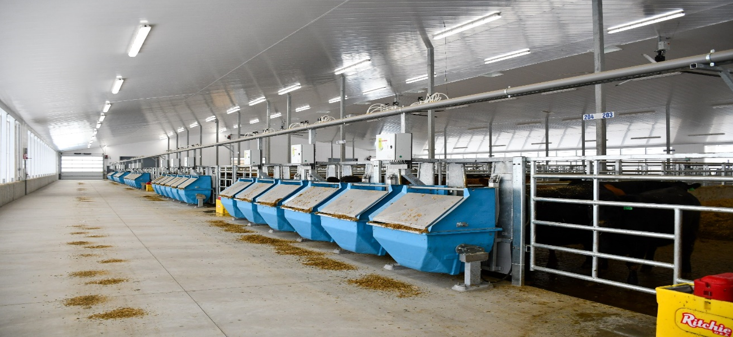
Financial information
Performance measures
In accordance with the performance measures framework outlined in the MOU between ARIO and the ministry, the following performance measures in the area of infrastructure planning and management have been identified.
Performance measure 1: Increased third party investment/collaboration in research and development infrastructure renewal
Target: Minimum of 20% of capital investment for new capital projects to come from non-government sources.
Results: The industry contributes a minimum of 20% of capital projects to research infrastructure. For current projects, the Beef Farmers of Ontario and Ontario Pork have committed to contributing 20% of the capital cost of new facilities. For beef, total project costs are to be $15.5M, with $3M from industry. For swine, the estimated budget is $15M (pending completion of the design phase).
Performance measure 2: Research Station Utilization represented by the percentage of utilization and available capacity at each ARIO research station
Target: Livestock research stations: 44%; crop research stations: 78%
Results: ARIO property use and capacity is measured through the calculation of a utilization rate for each Research Station, with the 2020/11 utilization rates used as targets. For Livestock Research Stations, the unit of tracking is an Animal Research Day (ARD). Animal use is strictly controlled by Animal Use Protocols (AUPs) required under the Animals for Research Act and the Canadian Council on Animal Care. Station managers report on actual number of days each animal is used under each trial. It is possible for animals to be used on concurrent trials if the parameters of the trial do not interfere with each other. For Crop Research Stations, the unit of tracking is land area used for plots (hectares (ha)). Area is allocated on a seasonal basis, and there is generally no overlap of trials.
The utilization rate is calculated by adding research utilization to the research preparation requirements and dividing the total by the capacity of the station. The research preparation requirement accounts for the need for crop rotation, replacement animals or cycle time in space-based animal facilities.
In general, the utilization rates for Crop Research Stations are higher than those of the Livestock Research Stations. Crop trials, to some extent, can expand to better utilize available research plot area by increasing replications or increasing the number of varieties being tested or evaluated for breeding or performance determination. Livestock trials, on the other hand, are more limited to the nature of the resident herd or available housing spaces or types and therefore cannot be easily scaled to increase usage. For example, in the beef cow-calf facilities at the Ontario Beef Research Centres at Elora and New Liskeard, calving occurs once per year in early spring. Trials looking at a short period of a calf’s development can only occur for the short duration post calving. It is not possible to bring in additional calves into the closed herd throughout the year, even though space may be available to conduct this type of work.
The Research Station capacity and utilization rates for 2019–20 are shown in the tables below. Livestock Research
Livestock research station capacity and utilization
Stations had an average utilization rate of 50.5% in 2019–20, exceeding the target of 49%. This was a small increase over the utilization rate for Livestock Research Stations in 2018–19. Utilization at the beef stations (Elora and New Liskeard) were lower than last year due to the transition to the new facility at Elora part way through the year. As experienced with the Ontario Dairy Research Centre, research projects tend to wind down leading up to a move to a new facility and can take several years to fully recover. This reduction in utilization was offset by increases at several other stations.
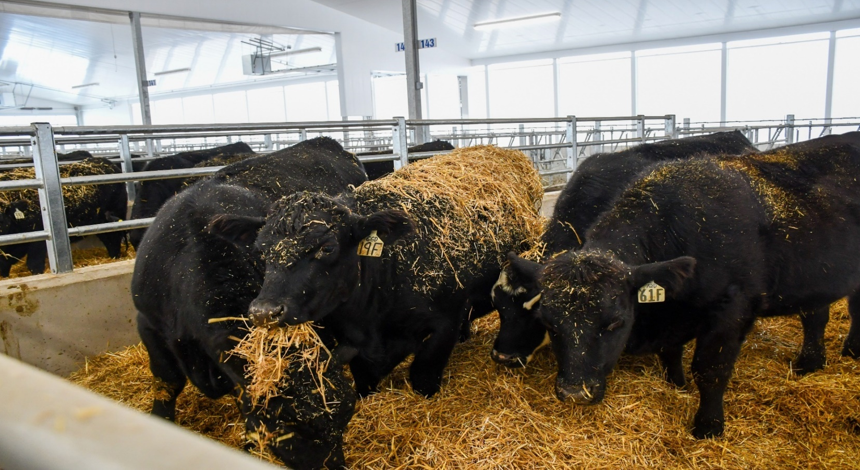
| Livestock research station | Capacity (ARD) | Research utilization (ARD) | Research preparation (ARD) | Utilization rate (%) |
|---|---|---|---|---|
| Alma - aquaculture | 111,690 | 8,961 | 28,105 | 33.2% |
| Arkell - equine | 11,680 | 11,113 | 365 | 98.3% |
| Arkell - poultry | 3,923,750 | 1,903,755 | 335,800 | 57.1% |
| Arkell - swine | 156,950 | 115,587 | 14,600 | 82.9% |
| Elora - beef | 206,995 | 14,595 | 38,895 | 25.8% |
| Elora - dairy | 173,010 | 54,723 | 83,950 | 80.2% |
| New Liskeard - beef | 164,250 | 140 | 27,375 | 16.8% |
| Ponsonby – general animal facility | 100,375 | 25,656 | 21,900 | 47.4% |
| Ponsonby - sheep | 102,200 | 2641 | 10,950 | 13.3% |
| Total - Livestock Stations | 4,950,900 | 2,137,171 | 561,940 | 50.5% |
2019–20 Value: 50.5%
Target: 49% ↑
2018–19 Value: 48.9% ↑
Research Preparation at Arkell – equine dropped from 1,095 in 2018–19 to 365 days in 2019–20, as only one horse was replaced versus three in the previous year.
Crop research station capacity and utilization
Crop research stations had an average utilization rate of 80.7% in 2019–20, exceeding the target of 78%. Elora and Ridgetown continue to post high utilization rates, while Emo and New Liskeard have space available for additional research projects. With the hiring of additional faculty in northern crops research, the utilization rates are expected to increase at those stations in the future.
There were several minor capacity modifications that occurred in the Crop Research Stations data in 2019–20. Capacity at Emo was reduced from 21.25 ha to 17.85 ha based on remeasurement of non-cropped areas. Similarly, Simcoe capacity was reduced from 69.40 ha to 46.78 ha based on remeasurement of building, parking and lawn areas and reclassification of some areas as not suitable for research. Winchester capacity increased from 36.42 ha to 40.51 ha based on remeasurement of building and yard areas following construction of the new buildings. Finally, Woodstock capacity was reduced from 60.70 ha to 58.88 ha, as more area was leased by the Canadian Outdoor Farm Show for demonstration purposes in 2019–20. The net result was that capacity available for research plots was reduced from 618.81 ha in 2018–19 to 595.13 ha in 2019–20. Research preparation area, which is the area used from crop rotation increased from 236.17 ha in 2018–19 to 249.81 ha in 2019–20. Rotation varies based on agronomic practice and the specific requirements of the research projects. Overall, research utilization increased from 251.07 ha to 253.13 ha in 2019–20.
| Crop research station | Capacity (plot area (ha)) | Research utilization (plot area (ha)) | Research preparation (plot area (ha)) | Utilization rate (%) |
|---|---|---|---|---|
| Cedar Springs | 7.28 | 6.47 | 0.00 | 88.9% |
| Elora | 154.35 | 54.31 | 95.51 | 97.1% |
| Emo | 17.85 | 6.64 | 1.05 | 43.1% |
| Guelph | 76.89 | 55.68 | 0.00 | 72.4% |
| Huron | 42.90 | 21.85 | 18.62 | 94.3% |
| Muck | 2.06 | 1.86 | 0.00 | 90.2% |
| New Liskeard | 51.31 | 7.73 | 18.09 | 50.3% |
| Ridgetown | 96.32 | 39.66 | 52.61 | 95.8% |
| Simcoe | 46.78 | 25.50 | 17.40 | 91.7% |
| Winchester | 40.51 | 17.04 | 19.42 | 90.0% |
| Woodstock | 58.88 | 16.39 | 27.11 | 73.9% |
| Total - Crop Stations | 595.13 | 253.13 | 249.81 | 80.7% |
2019–20 Value: 80.7%
Target: 78% ↑
2018–19 Value: 78.1% ↑
The University of Guelph is pursuing opportunities to improve utilization rates through efficiency (such as allowing more trials to occur concurrently), infrastructure improvements (such as improved tile drainage allowing a greater number of trials to take place at stations) and encouraging additional research projects at underutilized stations and other actions to streamline research program administration. Considering these efforts are in the early stages, modest improvements in utilization should be expected in the future.
Audited financial statements
Footnotes
- footnote[1] Back to paragraph This is an average of the utilizations rates for each station.
- footnote[2] Back to paragraph This is an average of the utilizations rates for each station.